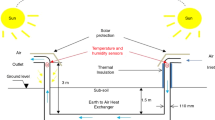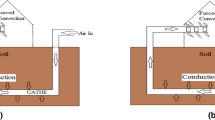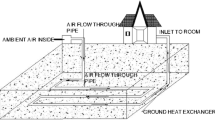Abstract
This study evaluates the cooling performance of a new hybrid system composing of an earth-to-air heat exchanger (EAHE) and a water spray channel to provide thermal comfort in Tehran, Iran. The inlet air temperature passing through the EAHE dissipates its heat to the surrounding soil and become slightly colder. To reach thermal comfort, the pre-cooled air flows upward through a channel spraying water downward and enters the living space. Considering the evaporative thermal comfort zone, the results showed that this system can meet comfort conditions for summer season Tehran. Moreover, according to the results, the cooling effectiveness of the proposed hybrid system is more than 100%, which means that the integrated system is capable of decreasing the air dry-bulb temperature below the inlet ambient wet-bulb temperature. Employing ground as a reliable source of alternative energy, the proposed cooling system can be considered an eco-friendly and energy-efficient system. Therefore, the introduced cooling system can be utilized as an alternative to conventional evaporative coolers or mechanical vapor compression systems while it can be considered an eco-friendly and energy-efficient system.












Similar content being viewed by others
Abbreviations
- A :
-
Annual amplitude of the ground surface temperature (°C)
- A d :
-
Water droplet surface area (m2)
- B :
-
Buoyancy (kg m s−2)
- C d :
-
Drag coefficient
- C pa :
-
Specific heat capacity of dry air (J kg−1 K−1)
- C ps :
-
Specific heat capacity of soil (J kg−1 K−1)
- C pma :
-
Specific heat capacity of moist air (J kg−1 K−1)
- C pv :
-
Specific heat capacity of water vapor (J kg−1 K−1)
- C pw :
-
Specific heat capacity of water (J kg−1 K−1)
- D :
-
Drag force (kg m s−2)
- d d :
-
Diameter of water droplet (m)
- f :
-
Friction factor
- G :
-
Gravity force (kg m s−2)
- h a :
-
Heat transfer coefficient of air (W m−2 K−1)
- h m :
-
Mass transfer coefficient (kg m−3 s−1)
- i a :
-
Enthalpy of dry air (kJ kg−1)
- i ma :
-
Enthalpy of moist air (kJ kg−1)
- i v :
-
Enthalpy of evaporation of water (kJ kg−1)
- i fgw0 :
-
Enthalpy of evaporation of water at 0 °C (kJ kg−1)
- i masw :
-
Enthalpy of saturated air (kJ kg−1)
- k a :
-
Thermal conductivity of air (W m−1 K−1)
- k s :
-
Thermal conductivity of soil (W m−1 K−1)
- Le:
-
Lewis factor
- \(\dot{m}_{\text{a}}\) :
-
Mass flow rate of air (kg s−1)
- m d :
-
Mass of water droplet (kg)
- \(\dot{m}_{\text{w}}\) :
-
Mass flow rate of water (kg s−1)
- Nu:
-
Nusselt number
- N d :
-
Number of water droplets in a control volume
- Pr:
-
Prandtl number
- Q s :
-
Heat transfer from soil (W)
- Q :
-
Total heat transfer (W)
- Q e :
-
Evaporative heat transfer (W)
- Q c :
-
Convective heat transfer (W)
- r 1 :
-
Pipe inside radius (m)
- R tot :
-
Overall thermal resistance (m2 K W−1)
- Re:
-
Reynolds number
- T :
-
Ground temperature (°C)
- T m :
-
Mean annual temperature of the ground (°C)
- T a :
-
Temperature of air (°C)
- T avg :
-
Average temperature (°C)
- T wb :
-
Wet-bulb temperature of air (°C)
- U d :
-
Internal energy of water droplet (J)
- U a :
-
Velocity of air (m s−1)
- U d :
-
Velocity of water droplets (m s−1)
- X, Y, Z :
-
Coordinate system (m)
- τ 0 :
-
Time delay (s)
- α s :
-
Thermal diffusivity of soil (m2 s−1)
- ε :
-
Cooling effectiveness
- ω a :
-
Absolute air humidity
- ω sw :
-
Absolute humidity of saturated air
- ρ a :
-
Density of air (kg m−3)
- ρ s :
-
Density of soil (kg m−3)
- ρ w :
-
Density of water (kg m−3)
References
Misra R, Bansal V, Das Agarwal G, Mathur J, Aseri T. Thermal performance investigation of hybrid earth air tunnel heat exchanger. Energy Build. 2012;49:531–5.
Sheikhani H, Barzegarian R, Heydari A, Kianifar A, Kasaeian A, Grόf G, Mahian O. A review of solar absorption cooling systems combined with various auxiliary energy devices. J Therm Anal Calorim. 2018;134(3):2197–212.
Darkwa J, Kokogiannakis G, Magadzire CL, Yuan K. Theoretical and practical evaluation of an earth-tube (E-tube) ventilation system. Energy Build. 2011;43:728–36.
Maerefat M, Haghighi AP. Passive cooling of buildings by using integrated earth to air heat exchanger and solar chimney. Renew Energy. 2010;35:2316–24.
Heidarinejad G, Khalajzadeh V, Delfani S. Performance analysis of a ground-assisted direct evaporative cooling air conditioner. Energy Build. 2010;45:2421–9.
Maerefat M, Haghighi AP. Natural cooling of stand-alone houses using solar chimney and evaporative cooling cavity. Renew Energy. 2010;35:2040–52.
Maerefat M, Ahmadi S, Haghighi AP. Investigation and performance analysis of a hybrid cooling system of air underground channel and direct evaporative cooler. Modares Mech Eng. 2015;15(5):137–44.
Afrand M, Shahsavar A, Talebizadeh PS, Sopian K, Salehipour H. Energy and exergy analysis of two novel hybrid solar photovoltaic geothermal energy systems incorporating a building integrated photovoltaic thermal system and an earth air heat exchanger system. Sol Energy. 2019;188:83–95.
Gilani N, Doustani AH, Shirmohammadi R. Developing of a novel water-efficient configuration for shower cooling tower integrated with the liquid desiccant cooling system. Appl Therm Eng. 2019;154:180–95.
Heidarinejad G, Pasdarshahri H. Potential of a desiccant-evaporative cooling system performance in a multi-climate country. Int J Refrig. 2011;34:1251–61.
Heidarinejad G, Farmahini MF, Delfani S. Investigation of a hybrid system of nocturnal radiative cooling and direct evaporative cooling. Build Environ. 2010;45:1521–8.
Haghighi AP, Mohabbati S. Performance analysis of wind catcher integrated with shower cooling system to meet thermal comfort conditions in buildings. J Cleaner Prod. 2017;148:452–66.
Aljubury MA, Ridha HD. Enhancement of evaporative cooling system in a greenhouse using geothermal energy. Renew Energy. 2017;111:321–31.
Bansal V, Misra R, Das Agrawal G, Mathur J. Performance analysis of integrated earth–air-tunnel-evaporative cooling system. Energy Build. 2012;47:525–32.
Chen H, Peng Y, Wang Y. Thermodynamic analysis of hybrid cooling system integrated with waste heat reusing and peak load shifting for data center. Energy Convers Manag. 2019;183:427–39.
Gandomkar A, Saidi MH, Shafii MB, Vandadi M, Kalan K. Visualization and comparative investigations of pulsating ferro-fluid heat pipe. Appl Therm Eng. 2017;116:56–65.
Ramezanizadeh M, Alhuyi Nazari M, Ahmadi MH, Chao KW. Experimental and numerical analysis of a nanofluidic thermosyphon heat exchanger. Eng Appl Comput Fluid Mech. 2018;13(1):40–7.
Ahmadi MH, Ramezanizadeh M, Alhuyi Nazari M, Lorenzini G, Kumar R, Jilte R. Applications of nanofluids in geothermal: a review. Math Model Eng Probab. 2018;5(4):281–5.
Ozgener L. A review on the experimental and analytical analysis of earth to air heat. Renew Sustain Energy Rev. 2011;15:4483–90.
Kusuda T, Archenbach P. Earth temperature and thermal diffusivity at selected stations in the United States. ASHRAE Trans. 1965;71:61–75.
De Paepe M, Janssens M. Thermo-hydraulic design of earth-air heat exchangers. Energy Build. 2003;35:389–97.
Xiaoni Q, Zhenyan L. Further investigation on the performance of a shower cooling tower. Energy Conv Manag. 2008;49:570–7.
González Pedraza OJ, Pacheco Ibarra JJ, Rubio-Maya C, Galván González SR, Rangel Arista JA. Numerical study of the drift and evaporation of water droplets cooled down. Appl Therm Eng. 2018;142:292–302.
Morsi SA, Alexander AJ. An investigation of particle trajectories in two-phase flow systems. J Fluid Mech. 1972;55(2):193–208.
Gilani N, Parpanji F. Parametric study on the outlet water temperature in a shower cooling tower and its application in different Iranian provincial capitals. Int J Therm Sci. 2018;124:174–86.
Bosnjakovic F. Technical thermodynamics. 1st ed. New York: Holt, Rinehart and Winston; 1965.
Qi X, Liu Z, Li D. Performance characteristics of a shower cooling tower. Energy Convers Manag. 2007;48:193–203.
Dhaliwal A, Goswami D, Das G. Heat transfer analysis inenvironmental control using an underground air tunnel. J Sol Energy Eng. 1985;5:107–41.
Xiaoni Q, Zhenyan L, Dandan L. Prediction of the performance of a shower cooling tower based on projection pursuit regression. Appl Therm Eng. 2008;28:1031–8.
Heidarinejad G, Delfani S. Selection of outdoor design condition instruction for designing of HVAC systems in cities of Iran. Tehran: Build Housing Res Cent Pub; 2007.
Misra R, Bansal V, Das Aarawal G, Mathur J, Aseri TK. CFD analysis based parametric study of derating factor for earth air tunnel. Appl Energy. 2013;103:266–77.
Benhammoua M, Draouib B. Parametric study on thermal performance of earth-to-air heat. Renew Sustain Energy Rev. 2015;44:348–55.
Zhao Y, Li R, Ji C, Huan C, Zhang B, Liu L. Parametric study and design of an earth-air heat exchanger using model. Appl Therm Eng. 2019;148:838–45.
Author information
Authors and Affiliations
Corresponding author
Additional information
Publisher's Note
Springer Nature remains neutral with regard to jurisdictional claims in published maps and institutional affiliations.
Rights and permissions
About this article
Cite this article
Ahmadi, S., Irandoost Shahrestani, M., Sayadian, S. et al. Performance analysis of an integrated cooling system consisted of earth-to-air heat exchanger (EAHE) and water spray channel. J Therm Anal Calorim 143, 473–483 (2021). https://doi.org/10.1007/s10973-020-09268-9
Received:
Accepted:
Published:
Issue Date:
DOI: https://doi.org/10.1007/s10973-020-09268-9




